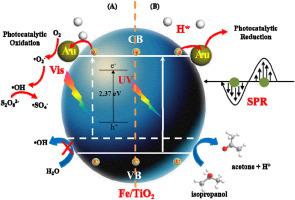Chemosphere ( IF 8.1 ) Pub Date : 2021-11-11 , DOI: 10.1016/j.chemosphere.2021.132826 Hangjun Zhang 1 , Yinan Zhang 1 , Yuchi Zhong 1 , Jiafeng Ding 1

|
Polychlorinated dibenzo-p-dioxins (PCDDs), characterized by their extreme toxicity, high persistency and bioaccumulation, regard as one of the most concerned environmental pollutants on the priority list. In this study, microwave-hydrothermal and photoreduction methods were adopted for fabrication of ternary Au@Fe/TiO2 composites for removal of 2,8-dichlorodibenzo-p-dioxin (2,8-DCDD) under UV–Vis light irradiation. The acquired materials were characterized and analyzed by XRD, TEM, XPS, UV–Vis DRS, PL, etc. As a result, the 1%Au@1%Fe/TiO2 exhibited much higher photocatalytic activity that 96.3% of 2,8-DCDD was removed within 160 min with respect to that of Fe/TiO2 (3.0 times) and TiO2 (5.5 times). It revealed the active substances might be produced, which were verified by ESR analysis. In a comparison, the 1%Au@1%Fe/TiO2 also exhibited high activity in that 97.2% of 2,8-DCDD was removed within 240 min under an anoxic atmosphere. The 1%Au@1%Fe/TiO2 systems were all pH-dependent that 2,8-DCDD could be fully degraded in neutral conditions. The results of repeatability on 1%Au@1%Fe/TiO2 showed that the sample was high stability. Fe doping improved the charge separation of TiO2 and Au modification improved the activity via SPR effect and Mott-Schottky barrier. The degradation mechanisms and pathways were proposed and discussed in detail. The current work develops a new approach on photocatalytic oxidation and reductive dechlorination of dioxins and may open a new opportunity to extend the application range of TiO2 catalysts.
中文翻译:

在紫外-可见光照射下使用三元金改性铁掺杂二氧化钛催化剂降解 2,8-二氯二苯并-对-二恶英的新策略
多氯二苯并二恶英(PCDDs)具有剧毒、高持久性和生物蓄积性等特点,被列为优先清单中最受关注的环境污染物之一。本研究采用微波-水热法和光还原法制备三元Au@Fe/TiO 2复合材料,在紫外-可见光照射下去除2,8-二氯二苯并-对二恶英(2,8-DCDD)。通过XRD、TEM、XPS、UV-Vis DRS、PL等对获得的材料进行了表征和分析。结果,1%Au@1%Fe/TiO 2表现出更高的光催化活性,2,8的96.3% -DCDD相对于Fe/TiO 2 (3.0倍)和TiO 2在160分钟内被去除(5.5 倍)。它揭示了可能产生的活性物质,并通过ESR分析验证。相比之下,1%Au@1%Fe/TiO 2也表现出高活性,因为在缺氧气氛下,240 分钟内 97.2% 的 2,8-DCDD 被去除。1%Au@1%Fe/TiO 2体系都依赖于pH,2,8-DCDD可以在中性条件下完全降解。1%Au@1%Fe/TiO 2的重复性结果表明该样品具有较高的稳定性。Fe掺杂改善了TiO 2的电荷分离Au 修饰通过 SPR 效应和 Mott-Schottky 势垒提高了活性。提出并详细讨论了降解机制和途径。目前的工作为二恶英的光催化氧化和还原脱氯开辟了一条新途径,并可能为拓宽TiO 2催化剂的应用范围开辟新的机遇。















































 京公网安备 11010802027423号
京公网安备 11010802027423号